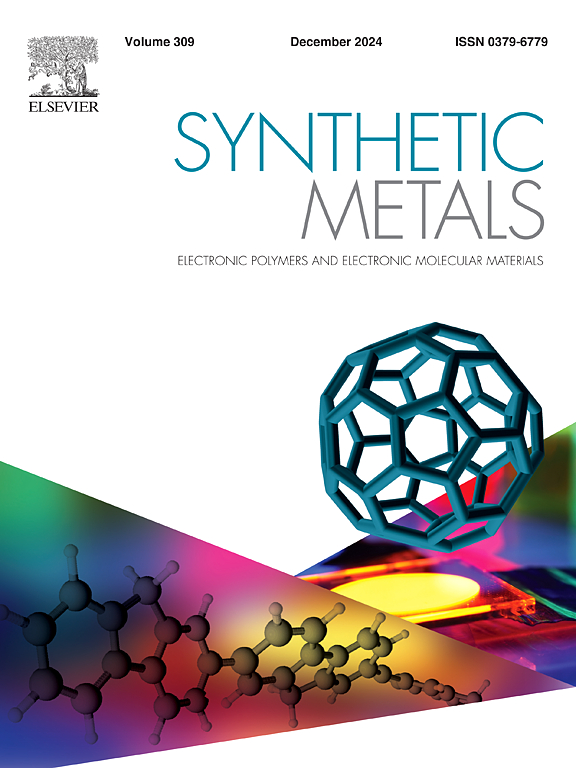聚[(苯胺-共-N-(4-磺酸苯基)苯胺]纳米纤维及其与二氧化钛纳米颗粒的纳米复合材料的机械化学合成、表征及其在混合太阳能电池中的效率研究
IF 4
3区 材料科学
Q2 MATERIALS SCIENCE, MULTIDISCIPLINARY
引用次数: 0
摘要
聚苯胺应用于新一代太阳能电池的优势包括成本效益高、合成过程环保、稳定性好,以及通过合成纳米复合材料改变带隙的能力。但其纳米结构面临的一个挑战是在包括水在内的无毒溶剂中的溶解度有限,这限制了其在涂层技术中的可加工性。我们通过合成其与二苯胺-4-磺酸盐的共聚物以及其与二氧化钛纳米颗粒(TiO2NPs)的纳米复合材料,克服了这一难题。因此,通过固态和无模板技术,并使用二苯胺-4-磺酸钠、苯胺盐酸盐、TiO2NPs 和 FeCl3∙6 H2O 作为氧化剂,聚(N-(磺化苯基)苯胺)纳米流体(PSANFLs)应运而生、合成了聚[(苯胺-N-(4-磺酸苯基)苯胺]纳米纤维(PAPSANFs)、聚(N-(磺酸苯基)苯胺)纳米纤维/二氧化钛纳米颗粒(PSANFs/TiO2NPs)和聚(苯胺-N-(4-磺酸苯基)苯胺)纳米纤维/二氧化钛纳米颗粒(PAPSANFs/TiO2NPs)。通过场发射扫描电子显微镜(FE-SEM)、傅立叶变换红外光谱、紫外可见光谱(UV-Vis)、循环伏安法(CV)和元素分析(CHNS)对合成样品进行了表征。FE-SEM 图像清楚地表明,合成样品具有纳米级尺寸。通过基于循环伏安曲线的电化学计算,确定了 PSANFs/TiO2NPs 纳米复合材料的带隙值为 2.23 eV,PAPSANFs/TiO2NPs 纳米复合材料的带隙值为 1.96 eV,展示了正负半导体的互补特性。利用刮刀法制备合成材料薄膜,并采用ITO│TiO2NPs│半导体样品│Al的结构模式,制备了所有混合太阳能电池。研究和讨论了样品的 I-V 特性和功率转换效率(PCE)。发现四个样品的 PCE 值在 0.20-0.82 % 之间。本文章由计算机程序翻译,如有差异,请以英文原文为准。
Mechanochemical synthesis and characterization of poly[(aniline-co-N-(4-sulfophenyl) aniline] nanofibers and its nanocomposite with titanium dioxide nanoparticles and study of their efficiency in hybrid solar cell
The advantages of polyaniline for application in new generation solar cells include its cost-effectiveness, environmentally friendly synthesis, remarkable stability, and the ability to modify the bandgap through the synthesis of its nanocomposites. But a challenge for its nanostructures is the limited solubility in non-toxic solvents, including water, which limits their processability in coating techniques. We overcame this challenge by synthesizing its copolymer with diphenylamine-4-sulfonate and its nanocomposite with titanium dioxide nanoparticles (TiO2NPs). So through a solid-state and template-free technique and using sodium diphenylamine-4-sulfonate, aniline hydrochloride salt, TiO2NPs, and FeCl3∙6 H2O as an oxidant, poly(N-(sulfophenyl)aniline) nanoflowers (PSANFLs), poly [(aniline-co-N-(4-sulfophenyl) aniline] nanofibers (PAPSANFs), poly(N-(sulfophenyl)aniline) nanofibers/titanium dioxide nanoparticles (PSANFs/TiO2NPs), and poly (aniline-co-N-(4-sulfophenyl)aniline nanofibers/titanium dioxide nanoparticles (PAPSANFs/TiO2NPs) were synthesized. Characterization of the synthesized samples was carried out through field emission scanning electron microscopy (FE-SEM), Fourier-transform infrared spectra, ultraviolet-visible spectra (UV-Vis), cyclic voltammetry (CV), and elemental analysis (CHNS). The FE-SEM images clearly illustrate that the synthesized samples are of nanoscale dimensions. The band gap values of 2.23 eV for PSANFs/TiO2NPs and 1.96 eV for PAPSANFs/TiO2NPs nanocomposites were determined through electrochemical calculations based on cyclic voltammetry curves, showcasing the complementary properties of n and p semiconductors. Using doctor blade method to prepare films from synthesized materials and the architectural pattern of ITO│TiO2NPs│semiconductor sample│Al, all hybrid solar cells are fabricated. The I-V characteristics and power conversion efficiency (PCE) of the samples were examined and discussed. The PCE values for the four samples were found to be in the range of 0.20–0.82 %.
求助全文
通过发布文献求助,成功后即可免费获取论文全文。
去求助
来源期刊

Synthetic Metals
工程技术-材料科学:综合
CiteScore
8.30
自引率
4.50%
发文量
189
审稿时长
33 days
期刊介绍:
This journal is an international medium for the rapid publication of original research papers, short communications and subject reviews dealing with research on and applications of electronic polymers and electronic molecular materials including novel carbon architectures. These functional materials have the properties of metals, semiconductors or magnets and are distinguishable from elemental and alloy/binary metals, semiconductors and magnets.
 求助内容:
求助内容: 应助结果提醒方式:
应助结果提醒方式:


